Recent Study Advances in Flexible Sensors Based on Polyimides
Abstract
:1. Introduction
2. Applications of PI in Sensors
2.1. Flexible Substrate
2.1.1. Traditional Flexible Substrate
2.1.2. PI Nanofiber Prepared by Electrospinning
2.2. Negative Friction Layer in TENG
2.2.1. PI Aerogel as Friction Layer
2.2.2. Modified PI as Friction Layer
2.3. Sensitive Layer in RH Sensor
2.3.1. Sensitive Layer in Capacitive RH Sensor
2.3.2. Sensitive Layer Based on FBG in RH Sensor
2.4. Insulation Layer and Dielectric Layer
2.5. Sacrificial Layer
2.6. Coating Material
3. Application of PI Graphitization to Graphene in Sensors
3.1. High-Temperature Graphitization of PI
3.2. LIG Based on PI
4. Challenges and Perspectives Analysis
5. Conclusions
Author Contributions
Funding
Institutional Review Board Statement
Informed Consent Statement
Data Availability Statement
Conflicts of Interest
References
- Han, S.T.; Peng, H.; Sun, Q.; Venkatesh, S.; Chung, K.S.; Lau, S.C.; Zhou, Y.; Roy, V.A.L. An overview of the development of flexible sensors. Adv. Mater. 2017, 29, 1700375. [Google Scholar] [CrossRef] [PubMed]
- Zazoum, B.; Batoo, K.M.; Khan, M.A.A. Recent advances in flexible sensors and their applications. Sensors 2022, 22, 4653. [Google Scholar] [CrossRef] [PubMed]
- Luo, Y.; Abidian, M.R.; Ahn, J.H.; Akinwande, D.; Andrews, A.M.; Antonietti, M.; Bao, Z.; Berggren, M.; Berkey, C.A.; Bettinger, C.J.; et al. Technology roadmap for flexible sensors. ACS Nano 2023, 17, 5211–5295. [Google Scholar] [CrossRef] [PubMed]
- Wan, Y.; Wang, Y.; Guo, C.F. Recent progresses on flexible tactile sensors. Mater. Today Phys. 2017, 1, 61–73. [Google Scholar] [CrossRef]
- Yi, C.; Li, W.; Shi, S.; He, K.; Ma, P.; Chen, M.; Yang, C. High-temperature-resistant and colorless polyimide: Preparations, properties, and applications. Sol. Energy 2020, 195, 340–354. [Google Scholar] [CrossRef]
- Amjadi, M.; Pichitpajongkit, A.; Lee, S.; Ryu, S.; Park, I. Highly stretchable and sensitive strain sensor based on silver nanowire–elastomer nanocomposite. ACS Nano 2014, 8, 5154–5163. [Google Scholar] [CrossRef]
- Zhao, F.; He, J.; Li, X.; Bai, Y.; Ying, Y.; Ping, J. Smart plant-wearable biosensor for in-situ pesticide analysis. Biosens. Bioelectron. 2020, 170, 112636. [Google Scholar] [CrossRef] [PubMed]
- Wang, J.; Wang, N.; Xu, D.; Tang, L.; Sheng, B. Flexible humidity sensors composed with electrodes of laser induced graphene and sputtered sensitive films derived from poly(ether-ether-ketone). Sens. Actuators B Chem. 2023, 375, 132846. [Google Scholar] [CrossRef]
- Tur-García, E.L.; Davis, F.; Collyer, S.D.; Holmes, J.L.; Barr, H.; Higson, S.P.J. Novel flexible enzyme laminate-based sensor for analysis of lactate in sweat. Sens. Actuators B Chem. 2017, 242, 502–510. [Google Scholar] [CrossRef]
- Lamanna, L.; Rizzi, F.; Guido, F.; Algieri, L.; Marras, S.; Mastronardi, V.M.; Qualtieri, A.; De Vittorio, M. Flexible and transparent aluminum-nitride-based surface-acoustic-wave device on polymeric polyethylene naphthalate. Adv. Electron. Mater. 2019, 5, 1900095. [Google Scholar] [CrossRef]
- Ma, R.; Kwon, S.; Zheng, Q.; Kwon, H.Y.; Kim, J.I.; Choi, H.R.; Baik, S. Carbon-nanotube/silver networks in nitrile butadiene rubber for highly conductive flexible adhesives. Adv. Mater. 2012, 24, 3344–3349. [Google Scholar] [CrossRef] [PubMed]
- Chen, T.; Xie, Y.; Wang, Z.; Lou, J.; Liu, D.; Xu, R.; Cui, Z.; Li, S.; Panahi-Sarmad, M.; Xiao, X. Recent advances of flexible strain sensors based on conductive fillers and thermoplastic polyurethane matrixes. ACS Appl. Polym. Mater. 2021, 3, 5317–5338. [Google Scholar] [CrossRef]
- Wu, S.D.; Hsu, S.; Ketelsen, B.; Bittinger, S.C.; Schlicke, H.; Weller, H.; Vossmeyer, T. Fabrication of eco-friendly wearable strain sensor arrays via facile contact printing for healthcare applications. Small Methods 2023, 7, 2300170. [Google Scholar] [CrossRef] [PubMed]
- Deng, W.; Yang, T.; Jin, L.; Yan, C.; Huang, H.; Chu, X.; Wang, Z.; Xiong, D.; Tian, G.; Gao, Y.; et al. Cowpea-structured PVDF/ZnO nanofibers based flexible self-powered piezoelectric bending motion sensor towards remote control of gestures. Nano Energy 2019, 55, 516–525. [Google Scholar] [CrossRef]
- He, W.; Dai, Z.; Zou, K.; Li, X.; Hao, S.; Wang, H. Flexible piezoelectric PVDF nanofiber film sensor by blow spinning. Science China Technol. Sci. 2023, 66, 863–868. [Google Scholar] [CrossRef]
- Liu, Q.; Liu, Z.; Li, C.; Xie, K.; Zhu, P.; Shao, B.; Zhang, J.; Yang, J.; Zhang, J.; Wang, Q.; et al. Highly transparent and flexible iontronic pressure sensors based on an opaque to transparent transition. Adv. Sci. 2020, 7, 2000348. [Google Scholar] [CrossRef] [PubMed]
- Wang, X.; Sun, F.; Yin, G.; Wang, Y.; Liu, B.; Dong, M. Tactile-sensing based on flexible PVDF nanofibers via electrospinning: A review. Sensors 2018, 18, 330. [Google Scholar] [CrossRef] [PubMed]
- Li, B.; Yan, Z.; Zhang, T.; Jiang, S.; Wang, K.; Wang, D.; Liu, Y. Synthesis and properties of novel colorless and thermostable polyimides containing cross-linkable bulky tetrafluorostyrol pendant group and organosoluble triphenylmethane backbone structure. J. Polym. Sci. 2020, 58, 2355–2365. [Google Scholar] [CrossRef]
- Rim, Y.S.; Bae, S.H.; Chen, H.; De Marco, N.; Yang, Y. Recent progress in materials and devices toward printable and flexible sensors. Adv. Mater. 2016, 28, 4415–4440. [Google Scholar] [CrossRef]
- Saadatania, Z.; Mosanenzadeh, S.G.; Esmailzadeh, E.; Naguib, H. Performance-Enhanced Triboelectric Nanogenerator Using Polyimide Aerogel for Energy Harvesting and Sensing; SPIE: Bellingham, WA, USA, 2018; Volume 10601. [Google Scholar]
- Saadatnia, Z.; Mosanenzadeh, S.G.; Esmailzadeh, E.; Naguib, H.E. A high performance triboelectric nanogenerator using porous polyimide aerogel film. Sci. Rep. 2019, 9, 1370. [Google Scholar] [CrossRef]
- Shi, F.; Wei, X.; Wang, H.; Wu, X. Electrospun polyimide nanofiber-based triboelectric nanogenerator for harvesting energy at elevated temperatures. ACS Appl. Electron. Mater. 2022, 4, 4569–4575. [Google Scholar] [CrossRef]
- Hou, X.; Zhang, L.; Su, Y.; Gao, G.; Liu, Y.; Na, Z.; Xu, Q.; Ding, T.; Xiao, L.; Li, L.; et al. A space crawling robotic bio-paw (SCRBP) enabled by triboelectric sensors for surface identification. Nano Energy 2023, 105, 108013. [Google Scholar] [CrossRef]
- Dankoco, M.D.; Tesfay, G.Y.; Benevent, E.; Bendahan, M. Temperature sensor realized by inkjet printing process on flexible substrate. Mater. Sci. Eng. B 2016, 205, 1–5. [Google Scholar] [CrossRef]
- Wang, W.; Jiang, Y.; Zhong, D.; Zhang, Z.; Choudhury, S.; Lai, J.C.; Gong, H.; Niu, S.; Yan, X.; Zheng, Y.; et al. Neuromorphic sensorimotor loop embodied by monolithically integrated, low-voltage, soft e-skin. Science 2023, 380, 735–742. [Google Scholar] [CrossRef]
- Pang, C.; Lee, C.; Suh, K.Y. Recent advances in flexible sensors for wearable and implantable devices. J. Appl. Polym. Sci. 2013, 130, 1429–1441. [Google Scholar] [CrossRef]
- Yang, M.; Cheng, Y.; Yue, Y.; Chen, Y.; Gao, H.; Li, L.; Cai, B.; Liu, W.; Wang, Z.; Guo, H.; et al. High-performance flexible pressure sensor with a self-healing function for tactile feedback. Adv. Sci. 2022, 9, 2200507. [Google Scholar] [CrossRef] [PubMed]
- Li, X.; Huang, Z.; Shuck, C.E.; Liang, G.; Gogotsi, Y.; Zhi, C. MXene chemistry, electrochemistry and energy storage applications. Nat. Rev. Chem. 2022, 6, 389–404. [Google Scholar] [CrossRef] [PubMed]
- Jiang, X.; Liu, Q.; Xing, J.; Liu, N.; Guo, Y.; Liu, Z.; Zhao, J. Recent progress on 2D magnets: Fundamental mechanism, structural design and modification. Appl. Phys. Rev. 2021, 8, 031305. [Google Scholar] [CrossRef]
- Wei, Y.; Zhang, P.; Soomro, R.A.; Zhu, Q.; Xu, B. Advances in the synthesis of 2D mxenes. Adv. Mater. 2021, 33, 2103148. [Google Scholar] [CrossRef]
- Yao, Y.; Xiao, M.; Liu, W. A short review on self-healing thermoplastic polyurethanes. Macromol. Chem. Phys. 2021, 222, 2100002. [Google Scholar] [CrossRef]
- Zhu, M.; Yu, J.; Li, Z.; Ding, B. Self-healing fibrous membranes. Angew. Chem. Int. Ed. 2022, 61, e202208949. [Google Scholar] [CrossRef]
- Zhu, S.; Liu, Z.; Li, W.; Zhang, H.; Dai, G.; Zhou, X. Research progress of self-healing polymer materials for flexible electronic devices. J. Polym. Sci. 2023, 61, 1554–1571. [Google Scholar] [CrossRef]
- Li, B.; Cao, P.F.; Saito, T.; Sokolov, A.P. Intrinsically self-healing polymers: From mechanistic insight to current challenges. Chem. Rev. 2023, 123, 701–735. [Google Scholar] [CrossRef]
- Chen, K.; Ren, J.; Chen, C.; Xu, W.; Zhang, S. Safety and effectiveness evaluation of flexible electronic materials for next generation wearable and implantable medical devices. Nano Today 2020, 35, 100939. [Google Scholar] [CrossRef]
- Ding, Y.; Hou, H.; Zhao, Y.; Zhu, Z.; Fong, H. Electrospun polyimide nanofibers and their applications. Prog. Polym. Sci. 2016, 61, 67–103. [Google Scholar] [CrossRef]
- Jiang, S.; Hou, H.; Agarwal, S.; Greiner, A. Polyimide nanofibers by “green” electrospinning via aqueous solution for filtration applications. ACS Sustain. Chem. Eng. 2016, 4, 4797–4804. [Google Scholar] [CrossRef]
- Liu, J.; Min, Y.; Chen, J.; Zhou, H.; Wang, C. Preparation of the ultra-low dielectric constant polyimide fiber membranes enabled by electrospinning. Macromol. Rapid Commun. 2007, 28, 215–219. [Google Scholar] [CrossRef]
- Qi, L.; Jia, Y.J.; An, Y.C.; Zhi, X.X.; Zhang, Y.; Liu, J.G.; Li, J.S. Photo-patternable, high-speed electrospun ultrafine fibers fabricated by intrinsically negative photosensitive polyimide. ACS Omega 2021, 6, 18458–18464. [Google Scholar] [CrossRef]
- Qi, L.; Liu, J.; Yang, Y.; Guo, C.; Huangfu, M.; Zhang, Y. Solvent-resistant ultrafine nonwoven fibrous membranes by ultraviolet-assisted electrospinning of organo-soluble photosensitive polyimide resin. J. Appl. Polym. Sci. 2021, 138, 50048. [Google Scholar] [CrossRef]
- Gao, Q.; Agarwal, S.; Greiner, A.; Zhang, T. Electrospun fiber-based flexible electronics: Fiber fabrication, device platform, functionality integration and applications. Prog. Mater. Sci. 2023, 137, 101139. [Google Scholar] [CrossRef]
- Wang, T.; Zhang, J.; Li, J.; Lv, X.; Shan, L.; Zhang, G.; Sun, R.; Wong, C.P. Aminoquinoline-functionalized fluorographene quantum dots for low-temperature curable and low-dielectric photosensitive polyimide nanocomposites. Compos. Commun. 2023, 38, 101469. [Google Scholar] [CrossRef]
- Dong, K.; Wu, Z.; Deng, J.; Wang, A.C.; Zou, H.; Chen, C.; Hu, D.; Gu, B.; Sun, B.; Wang, Z.L. A stretchable yarn embedded triboelectric nanogenerator as electronic skin for biomechanical energy harvesting and multifunctional pressure sensing. Adv. Mater. 2018, 30, 1804944. [Google Scholar] [CrossRef] [PubMed]
- Wu, J.; Wang, X.; He, J.; Li, Z.; Li, L. Synthesis of fluorinated polyimide towards a transparent triboelectric nanogenerator applied on screen surface. J. Mater. Chem. A 2021, 9, 6583–6590. [Google Scholar] [CrossRef]
- Wang, H.L.; Guo, Z.H.; Zhu, G.; Pu, X.; Wang, Z.L. Boosting the power and lowering the impedance of triboelectric nanogenerators through manipulating the permittivity for wearable energy harvesting. ACS Nano 2021, 15, 7513–7521. [Google Scholar] [CrossRef] [PubMed]
- Peng, Z.; Xiao, X.; Song, J.; Libanori, A.; Lee, C.; Chen, K.; Gao, Y.; Fang, Y.; Wang, J.; Wang, Z.; et al. Improving relative permittivity and suppressing dielectric loss of triboelectric layers for high-performance wearable electricity generation. ACS Nano 2022, 16, 20251–20262. [Google Scholar] [CrossRef] [PubMed]
- Bui, V.T.; Huynh, N.D.; Chau, N.M.; Kim, W.; Kim, H.; Oh, I.K.; Huynh, D.P.; Choi, D. High-temperature operatable triboelectric nanogenerator using microdome-patterned polyimide for self-powered sensors. Nano Energy 2022, 101, 107612. [Google Scholar] [CrossRef]
- Liaw, D.J.; Wang, K.L.; Huang, Y.C.; Lee, K.R.; Lai, J.Y.; Ha, C.S. Advanced polyimide materials: Syntheses, physical properties and applications. Prog. Polym. Sci. 2012, 37, 907–974. [Google Scholar] [CrossRef]
- Chen, M.; Li, K.; Cheng, G.; He, K.; Li, W.; Zhang, D.; Li, W.; Feng, Y.; Wei, L.; Li, W.; et al. Touchpoint-tailored ultrasensitive piezoresistive pressure sensors with a broad dynamic response range and low detection limit. ACS Appl. Mater. Interfaces 2019, 11, 2551–2558. [Google Scholar] [CrossRef]
- Boutry, C.M.; Negre, M.; Jorda, M.; Vardoulis, O.; Chortos, A.; Khatib, O.; Bao, Z. A hierarchically patterned, bioinspired e-skin able to detect the direction of applied pressure for robotics. Sci. Robot. 2018, 3, eaau6914. [Google Scholar] [CrossRef]
- Lan, K.; Liu, S.; Wang, Z.; Wei, J.; Qin, G. High-performance olfactory receptor-derived peptide sensor for trimethylamine detection on the pyramid substrate structure. Sens. Actuators A Phys. 2023, 358, 114452. [Google Scholar] [CrossRef]
- Fang, X.; Min, L.; Qin, Z.; Gong, S.; Zhao, B.; Lv, Y.; Pan, K. High-performance MXene-based flexible and wearable pressure sensor based on a micro-pyramid structured active layer. Adv. Mater. Technol. 2023, 8, 2200291. [Google Scholar] [CrossRef]
- Ma, Y.; Xu, L.; He, Z.; Xie, J.; Shi, L.; Zhang, M.; Zhang, W.; Cui, W. Tunable dielectric and other properties in high-performance sandwich-type polyimide films achieved by adjusting the porous structure. J. Mater. Chem. C 2019, 7, 7360–7370. [Google Scholar] [CrossRef]
- Li, C.; Wang, P.; Zhang, D. Self-healable, stretchable triboelectric nanogenerators based on flexible polyimide for energy harvesting and self-powered sensors. Nano Energy 2023, 109, 108285. [Google Scholar] [CrossRef]
- Pang, L.; Li, Z.; Zhao, Y.; Zhang, X.; Du, W.; Chen, L.; Yu, A.; Zhai, J. Triboelectric nanogenerator based on polyimide/boron nitride nanosheets/polyimide nanocomposite film with enhanced electrical performance. ACS Appl. Electron. Mater. 2022, 4, 3027–3035. [Google Scholar] [CrossRef]
- Rivadeneyra, A.; Fernández-Salmerón, J.; Agudo, M.; López-Villanueva, J.A.; Capitan-Vallvey, L.F.; Palma, A.J. Design and characterization of a low thermal drift capacitive humidity sensor by inkjet-printing. Sens. Actuators B Chem. 2014, 195, 123–131. [Google Scholar] [CrossRef]
- Matsuguchi, M.; Kuroiwa, T.; Miyagishi, T.; Suzuki, S.; Ogura, T.; Sakai, Y. Stability and reliability of capacitive-type relative humidity sensors using crosslinked polyimide films. Sens. Actuators B Chem. 1998, 52, 53–57. [Google Scholar] [CrossRef]
- Yang, T.; Yu, Y.Z.; Zhu, L.S.; Wu, X.; Wang, X.H.; Zhang, J. Fabrication of silver interdigitated electrodes on polyimide films via surface modification and ion-exchange technique and its flexible humidity sensor application. Sens. Actuators B Chem. 2015, 208, 327–333. [Google Scholar] [CrossRef]
- Han, S.; Li, Y.; Hao, F.; Zhou, H.; Qi, S.; Tian, G.; Wu, D. Ultra-low dielectric constant polyimides: Combined efforts of fluorination and micro-branched crosslink structure. Eur. Polym. J. 2021, 143, 110206. [Google Scholar] [CrossRef]
- Kim, J.; Cho, J.H.; Lee, H.M.; Hong, S.M. Capacitive humidity sensor based on carbon black/polyimide composites. Sensors 2021, 21, 1974. [Google Scholar] [CrossRef]
- Malinský, P.; Romanenko, O.; Havránek, V.; Cutroneo, M.; Novák, J.; Štěpanovská, E.; Mikšová, R.; Marvan, P.; Mazánek, V.; Sofer, Z.; et al. Graphene oxide and polymer humidity micro-sensors prepared by carbon beam writing. Polymers 2023, 15, 1066. [Google Scholar] [CrossRef]
- Mu, Y.; Jin, P.; Zheng, L.; Wang, C.; Hou, Y.; Liu, W.; Si, L.; Liu, Z. An enhanced MEMS-based polyimide capacitive-type relative-humidity sensor with halloysite nanotube as a modifier. Microchem. J. 2023, 191, 108934. [Google Scholar] [CrossRef]
- Zhao, H.; Han, K.; Li, Y. Strip-type flexible capacitive humidity sensor based on composite of polyimide and poly(glycidyl methacrylate): Fabrication, humidity sensitive performance and potential for detecting water content in liquids. Colloids Surf. A: Physicochem. Eng. Asp. 2023, 675, 132092. [Google Scholar] [CrossRef]
- Broadway, C.; Min, R.; Leal-Junior, A.G.; Marques, C.; Caucheteur, C. Toward commercial polymer fiber Bragg grating sensors: Review and applications. J. Light. Technol. 2019, 37, 2605–2615. [Google Scholar] [CrossRef]
- Joe, H.E.; Yun, H.; Jo, S.H.; Jun, M.B.G.; Min, B.K. A review on optical fiber sensors for environmental monitoring. Int. J. Precis. Eng. Manuf. -Green Technol. 2018, 5, 173–191. [Google Scholar] [CrossRef]
- Presti, D.L.; Massaroni, C.; Leitão, C.S.J.; Domingues, M.D.F.; Sypabekova, M.; Barrera, D.; Floris, I.; Massari, L.; Oddo, C.M.; Sales, S.; et al. Fiber Bragg gratings for medical applications and future challenges: A review. IEEE Access 2020, 8, 156863–156888. [Google Scholar] [CrossRef]
- Wu, H.; Sun, T.; Peng, J.; Dai, J.; Yang, M. Polar-groups-modified polyimide based on a fiber Bragg grating for relative humidity sensors. Appl. Opt. 2020, 59, 2468–2473. [Google Scholar] [CrossRef] [PubMed]
- Xu, X.; Luo, M.; Liu, J.; Luan, N. Fluorinated polyimide-film based temperature and humidity sensor utilizing fiber Bragg grating. Sensors 2020, 20, 5469. [Google Scholar] [CrossRef]
- Du, W.; Li, Z.; Zhao, Y.; Zhang, X.; Pang, L.; Wang, W.; Jiang, T.; Yu, A.; Zhai, J. Biocompatible and breathable all-fiber-based piezoresistive sensor with high sensitivity for human physiological movements monitoring. Chem. Eng. J. 2022, 446, 137268. [Google Scholar] [CrossRef]
- Zhou, W.; Cao, G.; Yuan, M.; Zhong, S.; Wang, Y.; Liu, X.; Cao, D.; Peng, W.; Liu, J.; Wang, G.; et al. Core–shell engineering of conductive fillers toward enhanced dielectric properties: A universal polarization mechanism in polymer conductor composites. Adv. Mater. 2023, 35, 2207829. [Google Scholar] [CrossRef]
- Guo, Y.; Lyu, Z.; Yang, X.; Lu, Y.; Ruan, K.; Wu, Y.; Kong, J.; Gu, J. Enhanced thermal conductivities and decreased thermal resistances of functionalized boron nitride/polyimide composites. Compos. Part B Eng. 2019, 164, 732–739. [Google Scholar] [CrossRef]
- Li, X.; Zhang, B.; Wu, Z.; Liu, Y.; Hu, J.; Zhang, C.; Cao, G.; Zhang, K.; Sun, J.; Liu, X.; et al. Highly flexible, large scaled and electrical insulating polyimide composite paper with nanoscale polyimide fibers. Compos. Commun. 2023, 38, 101463. [Google Scholar] [CrossRef]
- Guo, F.; Shen, X.; Zhou, J.; Liu, D.; Zheng, Q.; Yang, J.; Jia, B.; Lau, A.K.T.; Kim, J.K. Highly thermally conductive dielectric nanocomposites with synergistic alignments of graphene and boron nitride nanosheets. Adv. Funct. Mater. 2020, 30, 1910826. [Google Scholar] [CrossRef]
- Zhu, Y.; Wu, Y.; Wang, G.; Wang, Z.; Tan, Q.; Zhao, L.; Wu, D. A flexible capacitive pressure sensor based on an electrospun polyimide nanofiber membrane. Org. Electron. 2020, 84, 105759. [Google Scholar] [CrossRef]
- Lee, J.I.; Shikida, M.; Sato, K. Polymer micromachining technologies for a table-shaped tactile sensor using thick sacrificial layer. Microsyst. Technol. 2015, 21, 239–246. [Google Scholar] [CrossRef]
- Carrasco, F.G.; Alonso, D.D.; Niño-de-Rivera, L. Biocompatibility and implant of a less invasive intraocular pressure sensor. Microelectron. Eng. 2016, 159, 32–37. [Google Scholar] [CrossRef]
- Walewyns, T.; Reckinger, N.; Ryelandt, S.; Pardoen, T.; Raskin, J.P.; Francis, L.A. Polyimide as a versatile enabling material for microsystems fabrication: Surface micromachining and electrodeposited nanowires integration. J. Micromechanics Microengineering 2013, 23, 095021. [Google Scholar] [CrossRef]
- Hamid, H.M.A.; Çelik-Butler, Z. A novel MEMS triboelectric energy harvester and sensor with a high vibrational operating frequency and wide bandwidth fabricated using UV-LIGA technique. Sens. Actuators A Phys. 2020, 313, 112175. [Google Scholar] [CrossRef]
- Wang, S.; Lin, L.; Wang, Z. Triboelectric nanogenerators as self-powered active sensors. Nano Energy 2015, 11, 436–462. [Google Scholar] [CrossRef]
- Wang, W.; Yang, D.; Yan, X.; Wang, L.; Hu, H.; Wang, K. Triboelectric nanogenerators: The beginning of blue dream. Front. Chem. Sci. Eng. 2023, 17, 635–678. [Google Scholar] [CrossRef]
- Kim, W.G.; Kim, D.W.; Tcho, I.W.; Kim, J.K.; Kim, M.S.; Choi, Y.K. Triboelectric nanogenerator: Structure, mechanism, and applications. ACS Nano 2021, 15, 258–287. [Google Scholar] [CrossRef]
- Li, D.; McDaniel, A.H.; Bastasz, R.; Medlin, J.W. Effects of a polyimide coating on the hydrogen selectivity of MIS sensors. Sens. Actuators B Chem. 2006, 115, 86–92. [Google Scholar] [CrossRef]
- Hou, J.; Dai, J.; Zhang, F.; Yang, M. Advanced fiber-optic relative humidity sensor based on graphene quantum dots doped polyimide coating. IEEE Photonics Technol. Lett. 2022, 34, 725–728. [Google Scholar] [CrossRef]
- Zhuang, Z.; Lu, Y.; Peng, J.; He, C. Fiber-optic macrobending-based temperature sensor with polyimide coating. Acta Opt. Sin. 2022, 42, 0706008. (In Chinese) [Google Scholar] [CrossRef]
- Lei, X.; Dong, X.; Lu, C. Sensitive humidity sensor based on a special dual-mode fiber. IEEE Sens. J. 2019, 19, 2587–2591. [Google Scholar] [CrossRef]
- Stolov, A.A.; Simoff, D.A.; Li, J.; Hokansson, A.S.; Hines, M.J. Behavior of specialty optical fibers in crude oil environment. J. Light. Technol. 2020, 38, 3759–3768. [Google Scholar] [CrossRef]
- Yang, G.; Yang, Y.; Chen, T.; Wang, J.; Ma, L.; Yang, S. Graphene/MXene composite aerogels reinforced by polyimide for pressure sensing. ACS Appl. Nano Mater. 2022, 5, 1068–1077. [Google Scholar] [CrossRef]
- Qin, Y.; Peng, Q.; Ding, Y.; Lin, Z.; Wang, C.; Li, Y.; Xu, F.; Li, J.; Yuan, Y.; He, X.; et al. Lightweight, superelastic, and mechanically flexible graphene/polyimide nanocomposite foam for strain sensor application. ACS Nano 2015, 9, 8933–8941. [Google Scholar] [CrossRef] [PubMed]
- Yao, K.; Song, C.; Fang, H.; Wang, F.; Chen, L.; Jiang, S.; Zha, G.; Hou, H. Freezing-extraction/vacuum-drying method for robust and fatigue-resistant polyimide fibrous aerogels and their composites with enhanced fire retardancy. Engineering 2023, 21, 152–161. [Google Scholar] [CrossRef]
- Zeng, Z.; Wu, N.; Wei, J.; Yang, Y.; Wu, T.; Li, B.; Hauser, S.B.; Yang, W.; Liu, J.; Zhao, S. Porous and ultra-flexible crosslinked MXene/polyimide composites for multifunctional electromagnetic interference shielding. Nanomicro. Lett. 2022, 14, 59. [Google Scholar] [CrossRef]
- Rahimi, R.; Ochoa, M.; Yu, W.; Ziaie, B. Highly stretchable and sensitive unidirectional strain sensor via laser carbonization. ACS Appl. Mater. Interfaces 2015, 7, 4463–4470. [Google Scholar] [CrossRef]
- Peng, H.; Zhao, W.; Chang, W.; Wang, Y. Research progress in preparation of laser-induced graphene and its applications. China Plastics 2021, 35, 124–135. (In Chinese) [Google Scholar] [CrossRef]
- Niu, Y.; Fang, Q.; Zhang, X.; Zhao, J.; Li, Y. Structural evolution, induced effects and graphitization mechanism of reduced graphene oxide sheets/polyimide composites. Compos. Part B Eng. 2018, 134, 127–132. [Google Scholar] [CrossRef]
- Zhang, F.; Feng, Y.; Qin, M.; Gao, L.; Li, Z.; Zhao, F.; Zhang, Z.; Lv, F.; Feng, W. Stress controllability in thermal and electrical conductivity of 3D elastic graphene-crosslinked carbon nanotube sponge/polyimide nanocomposite. Adv. Funct. Mater. 2019, 29, 1901383. [Google Scholar] [CrossRef]
- Lin, Y.; Hou, G.; Bi, S.; Su, X.; Li, H. Synthesis of reduced graphene oxide paper for EMI shielding by a multi-step process. Funct. Mater. Lett. 2020, 13, 2051024. [Google Scholar] [CrossRef]
- Duy, L.X.; Peng, Z.; Li, Y.; Zhang, J.; Ji, Y.; Tour, J.M. Laser-induced graphene fibers. Carbon 2018, 126, 472–479. [Google Scholar] [CrossRef]
- You, R.; Liu, Y.; Hao, Y.; Han, D.; Zhang, Y.; You, Z. Laser fabrication of graphene-based flexible electronics. Adv. Mater. 2020, 32, 1901981. [Google Scholar] [CrossRef] [PubMed]
- Vićentić, T.; Rašljić Rafajilović, M.; Ilić, S.D.; Koteska, B.; Madevska Bogdanova, A.; Pašti, I.A.; Lehocki, F.; Spasenović, M. Laser-induced graphene for heartbeat monitoring with heartpy analysis. Sensors 2022, 22, 6326. [Google Scholar] [CrossRef]
- Lin, J.; Peng, Z.; Liu, Y.; Ruiz-Zepeda, F.; Ye, R.; Samuel, E.L.G.; Yacaman, M.J.; Yakobson, B.I.; Tour, J.M. Laser-induced porous graphene films from commercial polymers. Nat. Commun. 2014, 5, 5714. [Google Scholar] [CrossRef]
- Tao, L.; Tian, H.; Liu, Y.; Ju, Z.; Pang, Y.; Chen, Y.; Wang, D.; Tian, X.; Yan, J.; Deng, N.; et al. An intelligent artificial throat with sound-sensing ability based on laser induced graphene. Nat. Commun. 2017, 8, 14579. [Google Scholar] [CrossRef]
- Chen, Y.; Long, J.; Zhou, S.; Shi, D.; Huang, Y.; Chen, X.; Gao, J.; Zhao, N.; Wong, C.P. UV laser-induced polyimide-to-graphene conversion: Modeling, fabrication, and application. Small Methods 2019, 3, 1900208. [Google Scholar] [CrossRef]
- Peng, Z.; Ye, R.; Mann, J.A.; Zakhidov, D.; Li, Y.; Smalley, P.R.; Lin, J.; Tour, J.M. Flexible boron-doped laser-induced graphene microsupercapacitors. ACS Nano 2015, 9, 5868–5875. [Google Scholar] [CrossRef] [PubMed]
- Liu, X.; Cheng, H.; Zhao, Y.; Wang, Y.; Li, F. Portable electrochemical biosensor based on laser-induced graphene and MnO2 switch-bridged DNA signal amplification for sensitive detection of pesticide. Biosens. Bioelectron. 2022, 199, 113906. [Google Scholar] [CrossRef] [PubMed]
- Li, J.; Liu, Y.; Yuan, L.; Zhang, B.; Bishop, E.S.; Wang, K.; Tang, J.; Zheng, Y.; Xu, W.; Niu, S.; et al. A tissue-like neurotransmitter sensor for the brain and gut. Nature 2022, 606, 94–101. [Google Scholar] [CrossRef] [PubMed]
- Yao, Y.; Jiang, Z.; Yao, J.; Luo, J.; Xu, C.; Chong, J.; Liu, T. Self-sealing carbon patterns by one-step direct laser writing and their use in multifunctional wearable sensors. ACS Appl. Mater. Interfaces 2020, 12, 50600–50609. [Google Scholar] [CrossRef] [PubMed]
- Yang, S.; Fan, l.; Ji, M.; Hu, A.; Yang, H.; Liu, J.; He, M. Advances in high temperature polyimide materials. Polym. Bull. 2011, 2011, 70–78. (In Chinese) [Google Scholar] [CrossRef]
- Zhou, C.; Zhou, H.; He, Y.; Yang, M.; Xiong, Y.; Xu, L.; Wang, Y. Optical and irradiation-resistant properties of ITO films on F46 and PI substrates. Trans. Tianjin Univ. 2019, 25, 195–200. [Google Scholar] [CrossRef]
- Wang, Y.; Adam, M.L.; Zhao, Y.; Zheng, W.; Gao, L.; Yin, Z.; Zhao, H. Machine learning-enhanced flexible mechanical sensing. Nanomicro Lett. 2023, 15, 55. [Google Scholar] [CrossRef] [PubMed]
- Wu, S.; Kondo, Y.; Kakimoto, M.; Yang, B.; Yamada, H.; Kuwajima, I.; Lambard, G.; Hongo, K.; Xu, Y.; Shiomi, J.; et al. Machine-learning-assisted discovery of polymers with high thermal conductivity using a molecular design algorithm. NPJ Comput. Mater. 2019, 5, 66. [Google Scholar] [CrossRef]
- Tao, L.; He, J.; Munyaneza, N.E.; Varshney, V.; Chen, W.; Liu, G.; Li, Y. Discovery of multi-functional polyimides through high-throughput screening using explainable machine learning. Chem. Eng. J. 2023, 465, 142949. [Google Scholar] [CrossRef]
- Butler, K.T.; Davies, D.W.; Cartwright, H.; Isayev, O.; Walsh, A. Machine learning for molecular and materials science. Nature 2018, 559, 547–555. [Google Scholar] [CrossRef]
- Jha, D.; Ward, L.; Paul, A.; Liao, W.; Choudhary, A.; Wolverton, C.; Agrawal, A. Elemnet: Deep learning the chemistry of materials from only elemental composition. Sci. Rep. 2018, 8, 17593. [Google Scholar] [CrossRef] [PubMed]
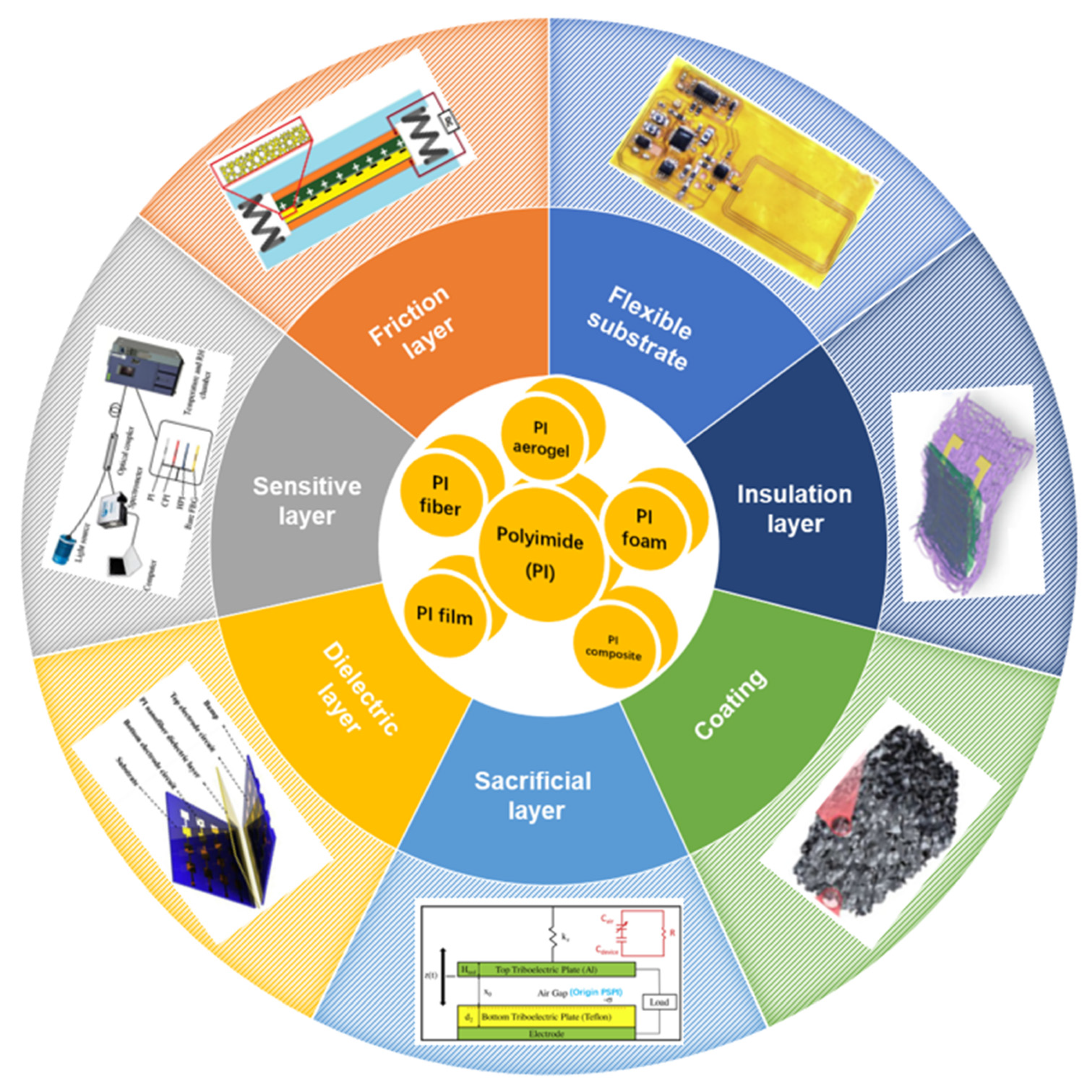
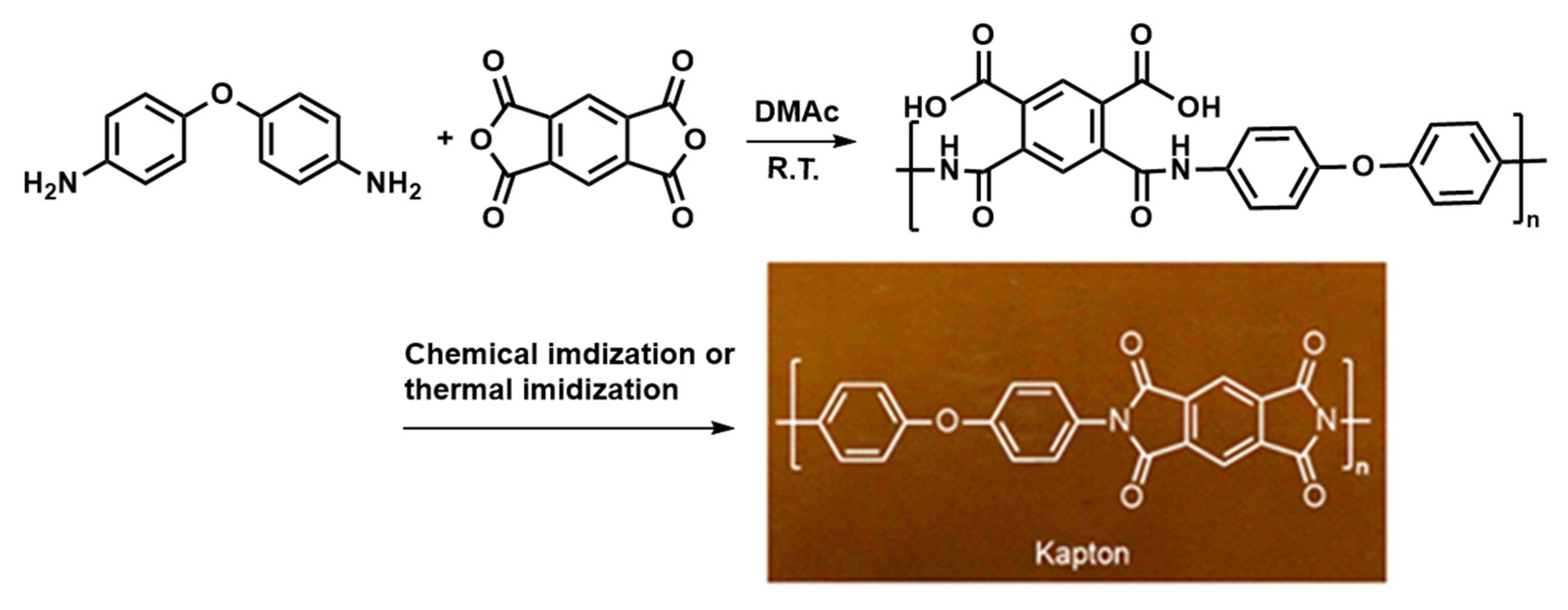
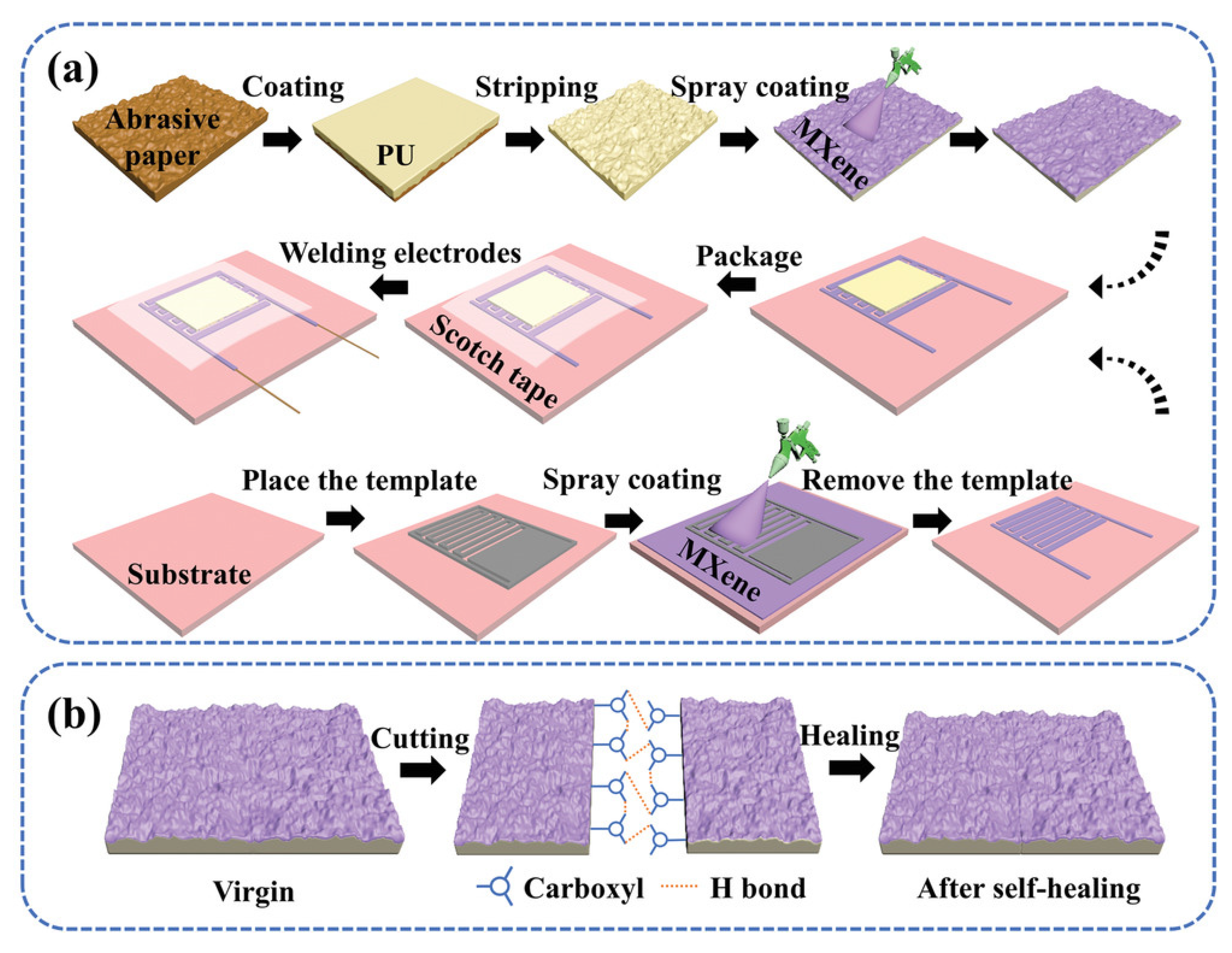
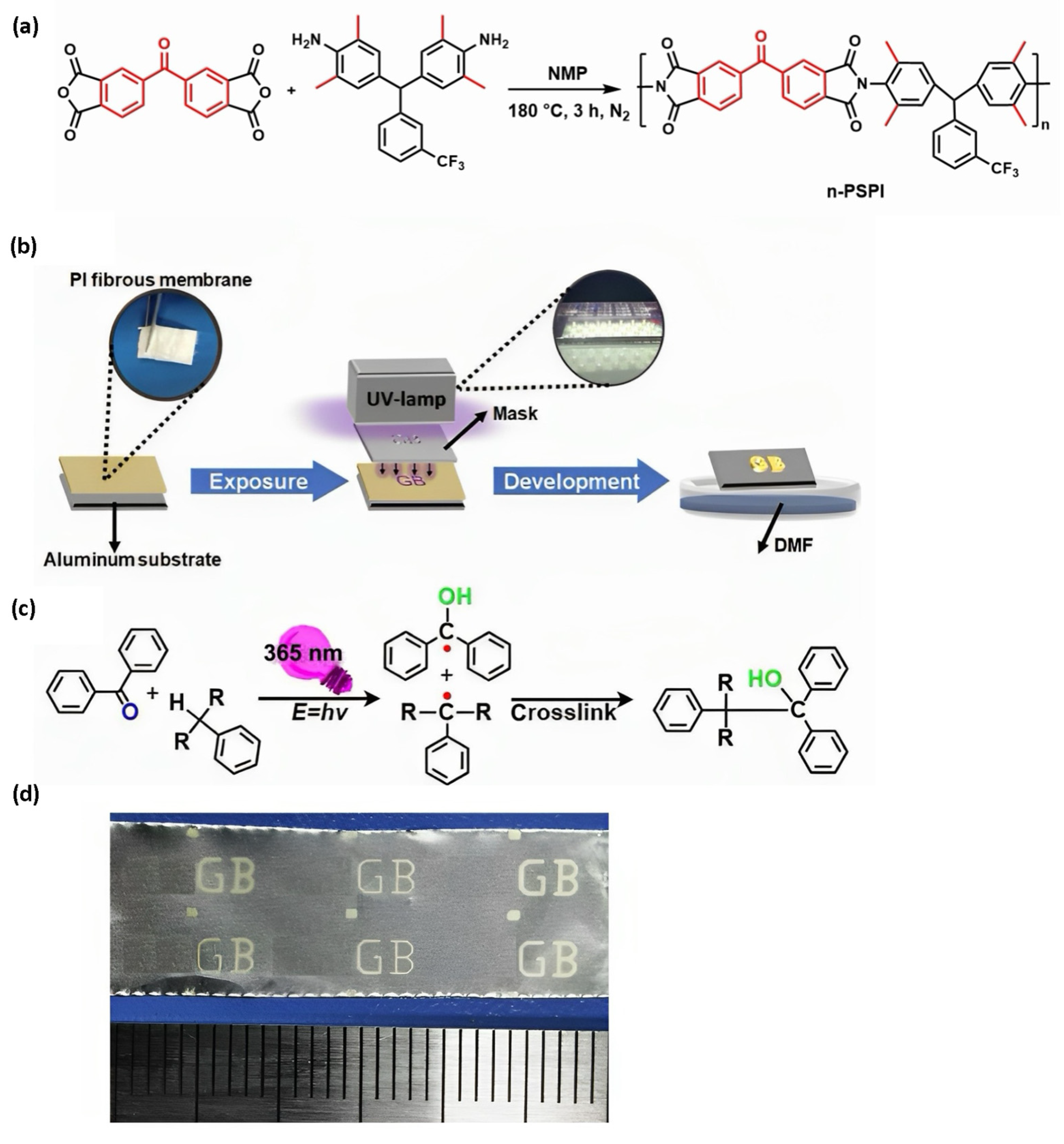

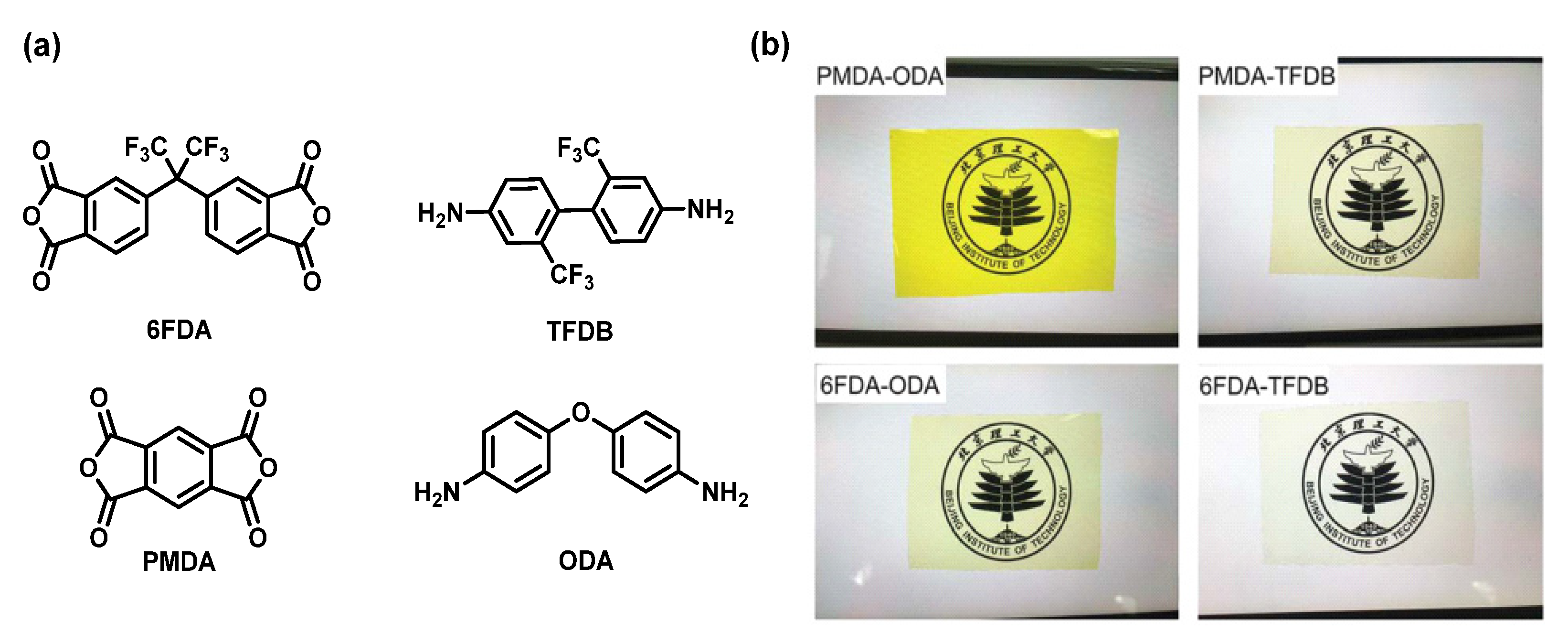

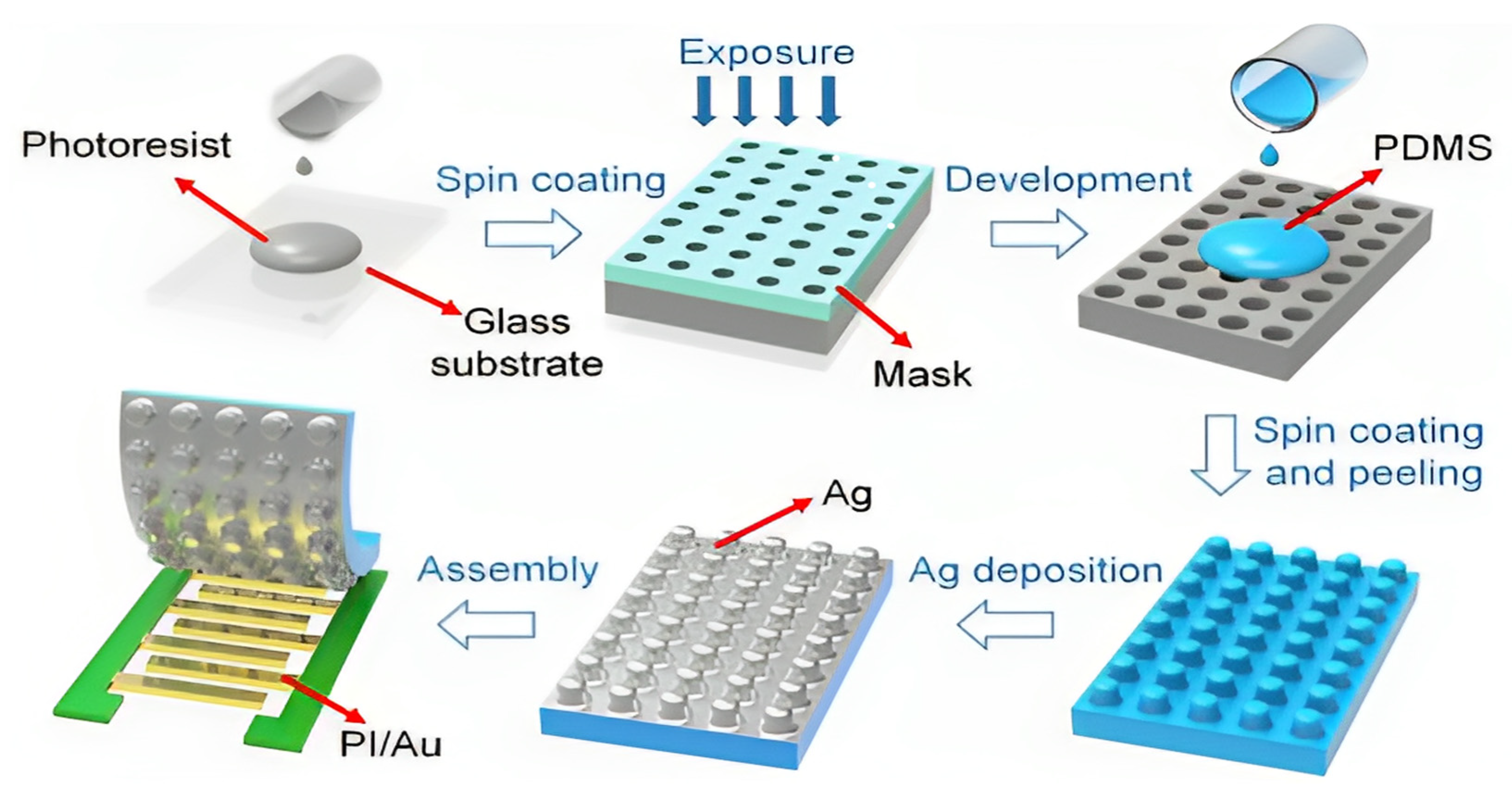




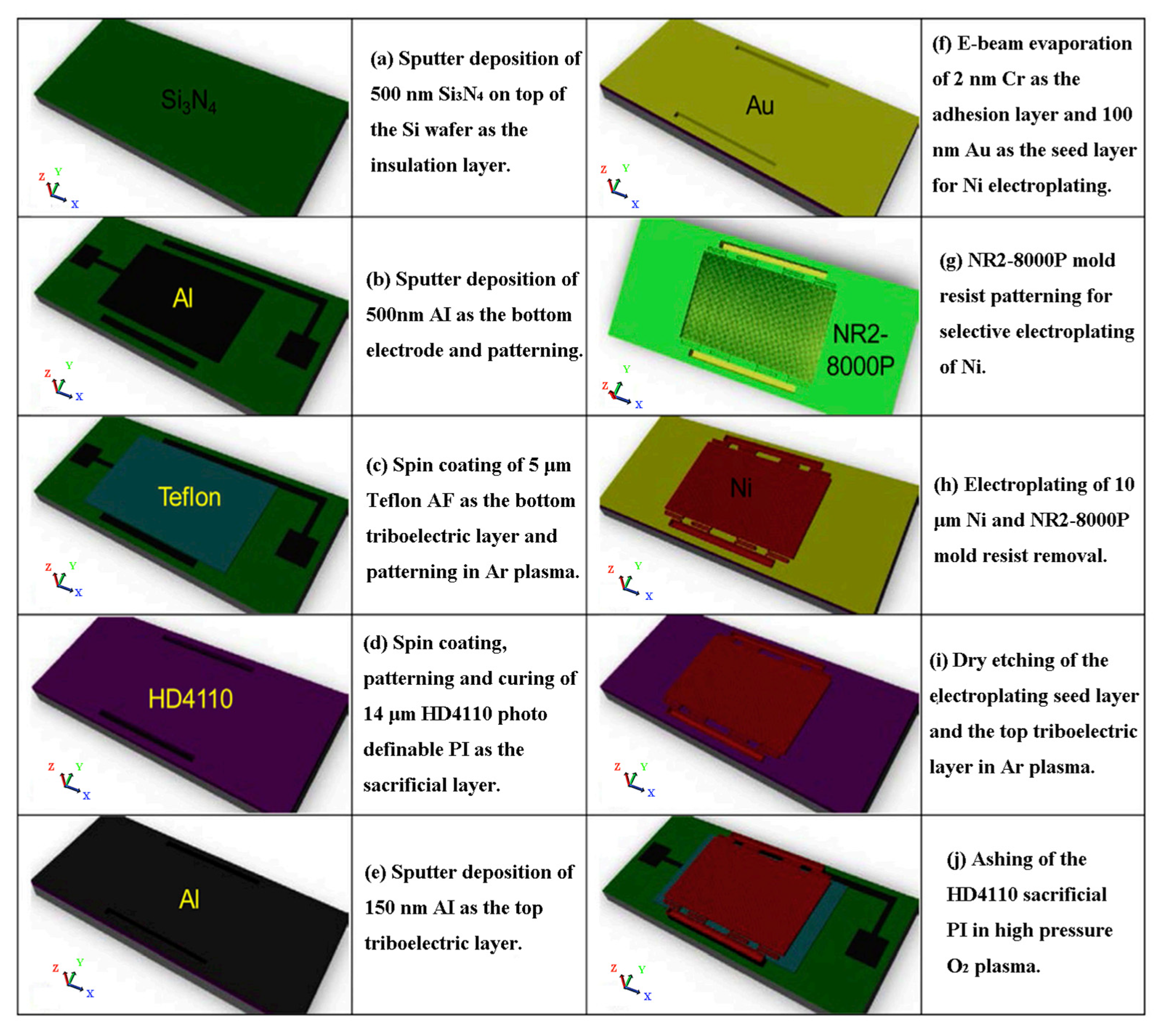
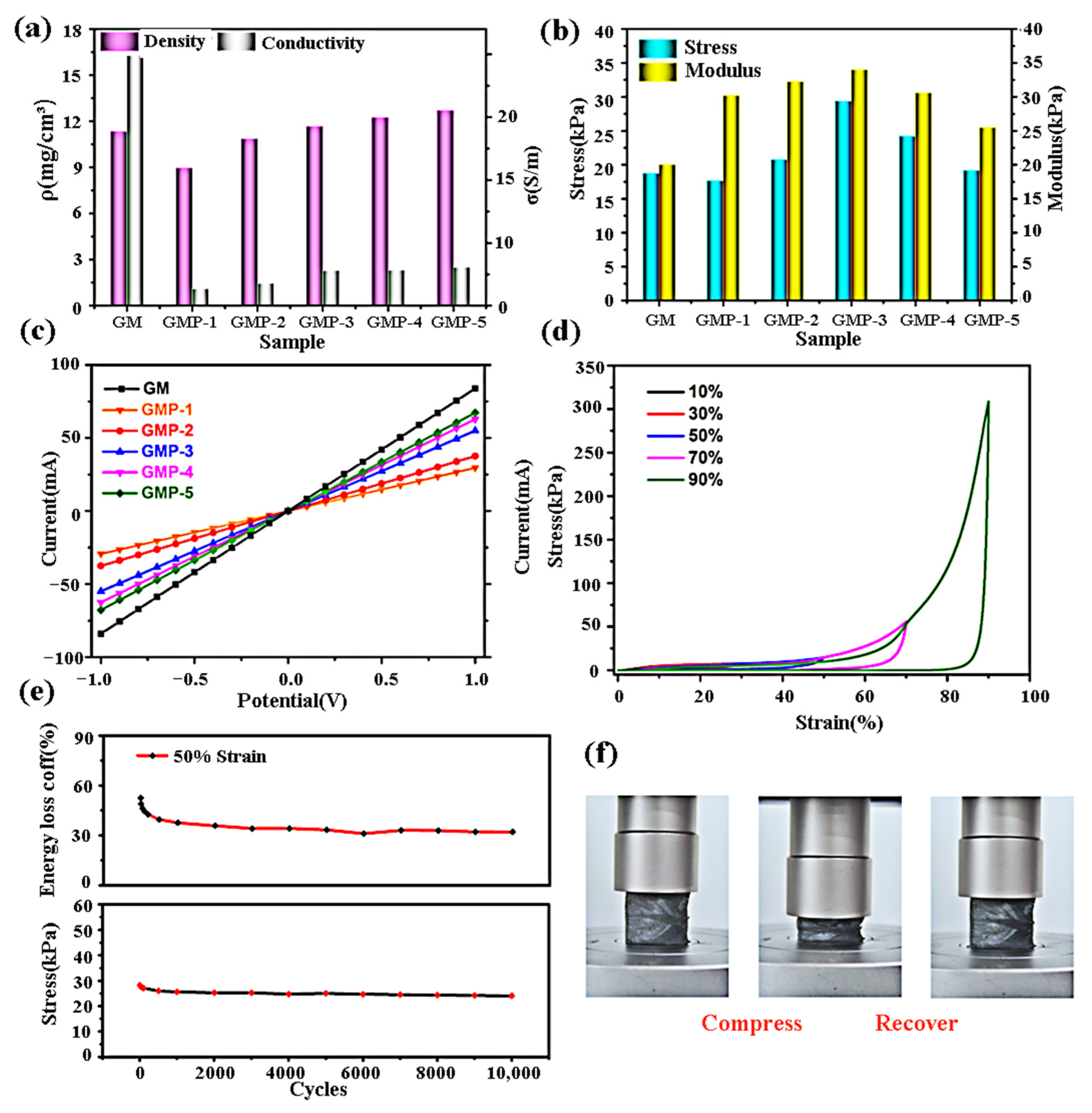
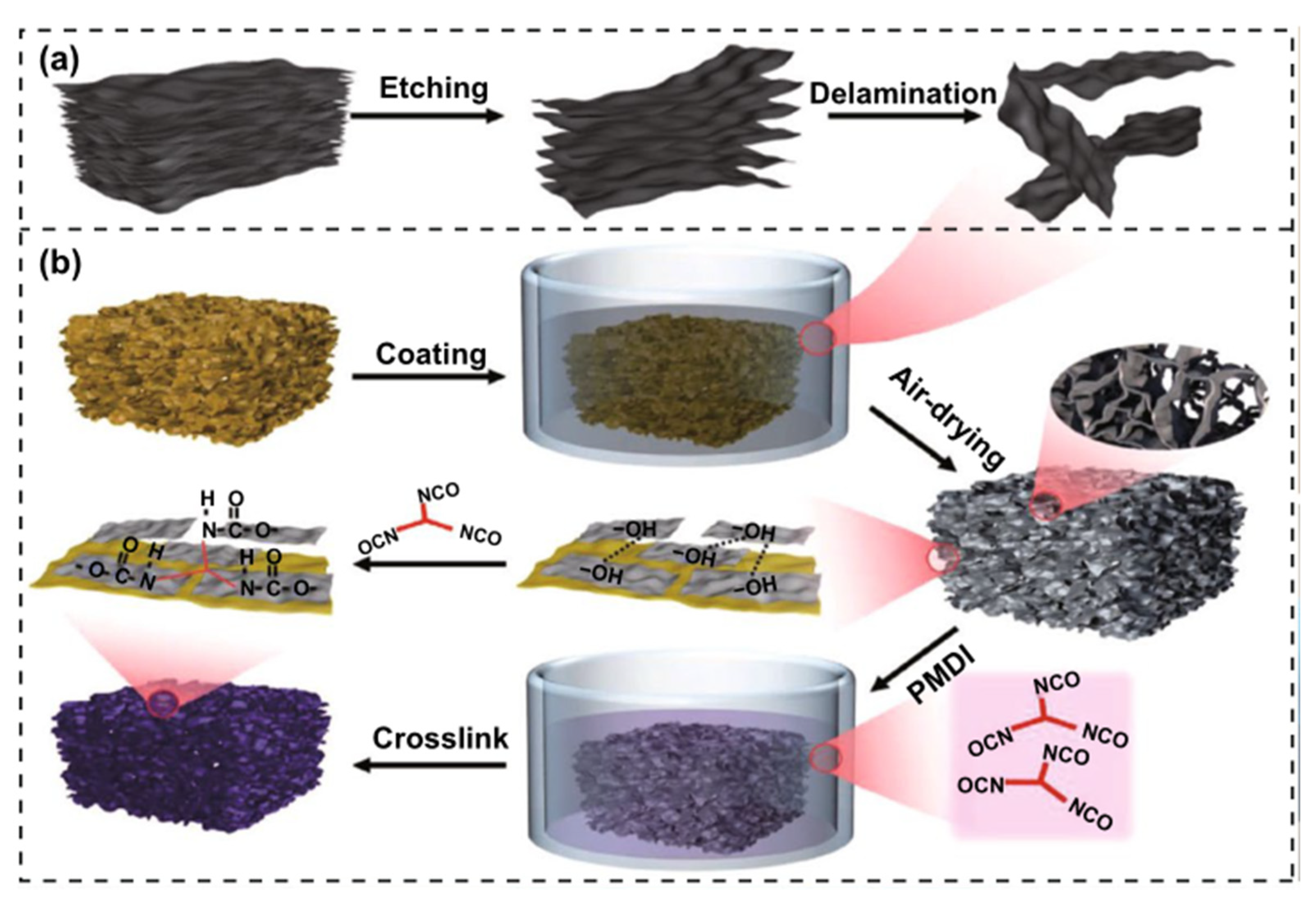


| Sensitivity | Response Time/ms | Recovery Time/ms | |||
|---|---|---|---|---|---|
| In Low Pressure/kPa−1 | In Middle Pressure/kPa−1 | In High Pressure/kPa−1 | |||
| PI | 281.54 | 509.78 | 66.68 | 67.8 | 44.8 |
| Membrane filter | 99.8 | 408.4 | 23.4 | 68.4 | 46.5 |
| Name | Parameters | Advantages | Disadvantages | Ref. |
|---|---|---|---|---|
| 50% open-cell content PI aerogel | Voc: 40 V Isc: 5 μA Pt max: 47 μW | Lightweight, efficient | The process is complex and uneconomical | [20,21] |
| Fluorinated PI (6FDA-TFDB) | Voc: 30 V Isc: 0.4 μA Charge density: 24.82 μC/m2 | High transparency, durability | Low power output, structural requirements | [44] |
| Md-PI (md-PI_95) | Voc: 122.20 V Isc: 4.4 μA Output power: 1.42 W/m2 Charge density: 58.4 μC/m2 | Superior electrical output, durability, and thermal stability | Strict requirements for PI solubility | [47] |
Disclaimer/Publisher’s Note: The statements, opinions and data contained in all publications are solely those of the individual author(s) and contributor(s) and not of MDPI and/or the editor(s). MDPI and/or the editor(s) disclaim responsibility for any injury to people or property resulting from any ideas, methods, instructions or products referred to in the content. |
© 2023 by the authors. Licensee MDPI, Basel, Switzerland. This article is an open access article distributed under the terms and conditions of the Creative Commons Attribution (CC BY) license (https://creativecommons.org/licenses/by/4.0/).
Share and Cite
Zhang, T.; Chai, Y.; Wang, S.; Yu, J.; Jiang, S.; Zhu, W.; Fang, Z.; Li, B. Recent Study Advances in Flexible Sensors Based on Polyimides. Sensors 2023, 23, 9743. https://doi.org/10.3390/s23249743
Zhang T, Chai Y, Wang S, Yu J, Jiang S, Zhu W, Fang Z, Li B. Recent Study Advances in Flexible Sensors Based on Polyimides. Sensors. 2023; 23(24):9743. https://doi.org/10.3390/s23249743
Chicago/Turabian StyleZhang, Tianyong, Yamei Chai, Suisui Wang, Jianing Yu, Shuang Jiang, Wenxuan Zhu, Zihao Fang, and Bin Li. 2023. "Recent Study Advances in Flexible Sensors Based on Polyimides" Sensors 23, no. 24: 9743. https://doi.org/10.3390/s23249743
APA StyleZhang, T., Chai, Y., Wang, S., Yu, J., Jiang, S., Zhu, W., Fang, Z., & Li, B. (2023). Recent Study Advances in Flexible Sensors Based on Polyimides. Sensors, 23(24), 9743. https://doi.org/10.3390/s23249743






